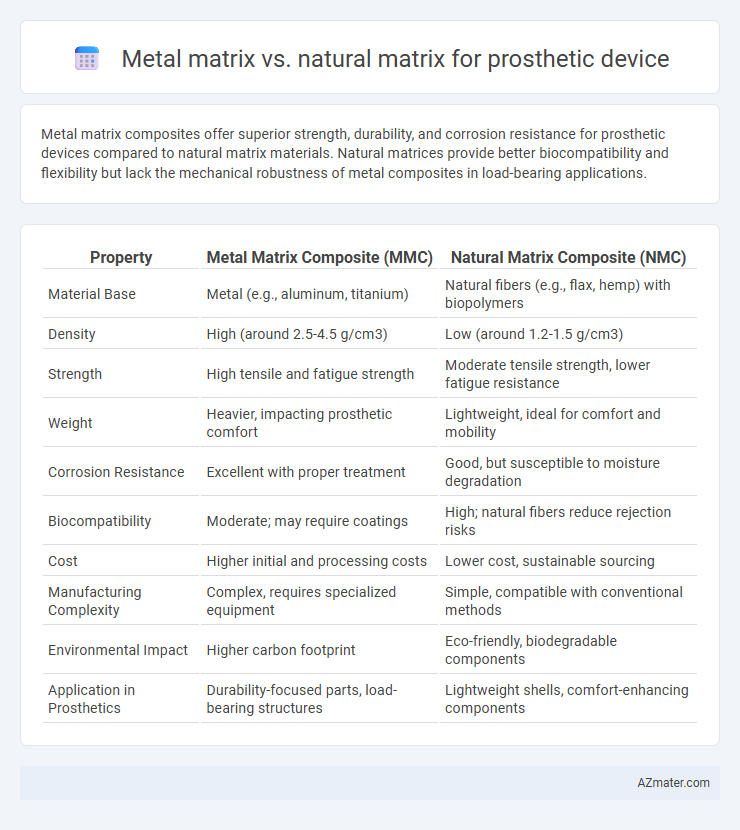Metal matrix composites offer superior strength, durability, and corrosion resistance for prosthetic devices compared to natural matrix materials. Natural matrices provide better biocompatibility and flexibility but lack the mechanical robustness of metal composites in load-bearing applications.
Table of Comparison
| Property | Metal Matrix Composite (MMC) | Natural Matrix Composite (NMC) |
|---|---|---|
| Material Base | Metal (e.g., aluminum, titanium) | Natural fibers (e.g., flax, hemp) with biopolymers |
| Density | High (around 2.5-4.5 g/cm3) | Low (around 1.2-1.5 g/cm3) |
| Strength | High tensile and fatigue strength | Moderate tensile strength, lower fatigue resistance |
| Weight | Heavier, impacting prosthetic comfort | Lightweight, ideal for comfort and mobility |
| Corrosion Resistance | Excellent with proper treatment | Good, but susceptible to moisture degradation |
| Biocompatibility | Moderate; may require coatings | High; natural fibers reduce rejection risks |
| Cost | Higher initial and processing costs | Lower cost, sustainable sourcing |
| Manufacturing Complexity | Complex, requires specialized equipment | Simple, compatible with conventional methods |
| Environmental Impact | Higher carbon footprint | Eco-friendly, biodegradable components |
| Application in Prosthetics | Durability-focused parts, load-bearing structures | Lightweight shells, comfort-enhancing components |
Introduction to Prosthetic Device Matrices
Prosthetic device matrices serve as the foundational structure that supports mechanical function and biocompatibility. Metal matrices, commonly composed of titanium or cobalt-chromium alloys, offer high strength, durability, and corrosion resistance essential for load-bearing applications. Natural matrices, often derived from collagen or chitosan, provide superior bioactivity and promote tissue integration but may lack the mechanical robustness required for long-term prosthetic use.
Overview of Metal Matrix Materials
Metal matrix materials for prosthetic devices primarily include titanium alloys, cobalt-chromium alloys, and stainless steel, known for their superior strength-to-weight ratios and biocompatibility. These metals provide excellent wear resistance and corrosion resistance, which are critical for long-term implant stability and performance. Their capacity to mimic the mechanical properties of bone while supporting osseointegration makes them a preferred choice over natural matrix materials in load-bearing prostheses.
Overview of Natural Matrix Materials
Natural matrix materials in prosthetic devices primarily include biopolymers such as collagen, chitosan, and silk fibroin, which offer excellent biocompatibility and biodegradability. These materials provide a favorable environment for cell attachment and tissue integration, enhancing the overall functionality and comfort of prosthetics. Their inherent bioactivity and ability to mimic the extracellular matrix make them ideal for applications requiring biointegration and minimal immune response.
Mechanical Strength: Metal vs Natural Matrices
Metal matrices in prosthetic devices exhibit significantly higher mechanical strength, offering superior load-bearing capacity and resistance to fatigue compared to natural matrices such as bone or composite fibers. The high tensile strength and stiffness of metals like titanium and stainless steel ensure durability and stability under repetitive stress, crucial for long-term prosthetic functionality. Natural matrices, while biocompatible and lightweight, generally lack the mechanical robustness to sustain heavy mechanical loads without deformation or failure.
Biocompatibility Comparison
Metal matrix composites exhibit excellent biocompatibility due to their corrosion resistance and mechanical properties that closely match human bone, reducing the risk of immune response and implant rejection. Natural matrix materials, such as collagen or chitosan, offer superior bioactivity and promote cell adhesion and tissue integration but may lack the mechanical strength required for load-bearing prosthetic applications. Combining metal matrices with natural components can enhance overall biocompatibility by providing structural support while fostering better biological interactions.
Customization and Adaptability
Metal matrix composites in prosthetic devices offer superior customization by allowing precise control over mechanical properties like stiffness and strength, enhancing patient-specific fit and durability. Natural matrix materials, derived from bio-based substances such as collagen or cellulose, provide excellent adaptability due to their biocompatibility, flexibility, and ability to mimic natural tissue behavior, improving user comfort and integration. Advances in additive manufacturing and hybrid material designs are accelerating tailored prosthetics that balance the robustness of metal matrices with the responsive characteristics of natural matrices.
Cost Analysis: Metal Matrix vs Natural Matrix
Metal matrix composites for prosthetic devices generally entail higher initial costs due to expensive raw materials like titanium or aluminum alloys and complex manufacturing processes such as powder metallurgy or casting. Conversely, natural matrix materials, including bio-based polymers and composites reinforced with natural fibers like flax or hemp, offer cost advantages through lower material expenses and simpler fabrication techniques. Lifecycle cost analysis also favors natural matrices by reducing maintenance expenses and enabling easier recycling or biodegradation, making them a financially sustainable alternative in prosthetic manufacturing.
Longevity and Wear Resistance
Metal matrix composites for prosthetic devices exhibit superior longevity and wear resistance due to their high strength-to-weight ratio and excellent fatigue properties. Natural matrix materials, such as bio-based polymers or composites, often lack the durability required for long-term use but offer better biocompatibility and environmental sustainability. The enhanced wear resistance of metal matrices results in reduced maintenance and longer replacement intervals compared to natural matrices in load-bearing prosthetics.
Clinical Outcomes and Patient Satisfaction
Metal matrix prosthetic devices demonstrate superior durability and load-bearing capacity, leading to improved longevity and fewer revisions in clinical outcomes compared to natural matrix options. Patients report higher satisfaction rates with metal matrix prosthetics due to enhanced functionality and reduced wear-related complications. However, natural matrix devices offer better biocompatibility and integration, which may benefit patients with sensitivity issues or specific clinical conditions.
Future Trends in Prosthetic Matrix Development
Future trends in prosthetic matrix development emphasize hybrid composites combining metal matrix alloys with bio-derived natural matrices to optimize strength, biocompatibility, and weight reduction. Advanced manufacturing techniques like additive manufacturing enable precise control over matrix microstructures, enhancing mechanical performance and integration with human tissue. Research into biodegradable and smart materials within natural matrices points toward customizable, adaptive prosthetic devices that improve patient comfort and functionality.

Infographic: Metal matrix vs Natural matrix for Prosthetic device
 azmater.com
azmater.com